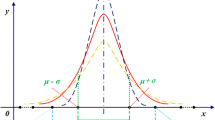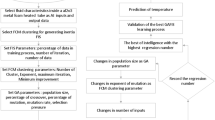Abstract
The interfacial heat transfer coefficient (IHTC) is one of the most important thermal-physical parameters in heat conduction problem. To solve the IHTC in gas cooling, a 304 stainless steel sample is heated up to 800 °C by an induction heating device and then cooled by a high-pressure gas source. The IHTC between the high-pressure gas and the sample is evaluated by ZFA-FEM (normal distribution method, firefly algorithm (FA) and finite element method (FEM)) and ZGFA-FEM (normal distribution method, global optimization factor (G), firefly algorithm and finite element method) according to the temperature curve attained in the experiment. The research results show that, these IHTCs attained in the solution of IHCP according to those temperature curves of CFD simulation and the experiment are consistent, and the trend of IHTC attained in the experiment is consistent with that in the literature. The group scale of fireflies in ZGFA is much smaller than that in ZFA. Only 20 fireflies in ZGFA can ensure all fireflies move to the optimal position due to global optimization factor used in ZGFA. The convergence, iteration and CPU time of ZGFA are better than ZFA.




















Similar content being viewed by others
Abbreviations
- λ :
-
Thermal conductivity of sample [W/m∙°C]
- c p :
-
Constant pressure specific heat of sample [J/Kg∙°C]
- ρ :
-
Density of sample [kg/m3]
- t :
-
Time [s]
- n :
-
Outer normal of boundary surface
- H k :
-
Convection coefficient [W/m2∙°C]
- H s :
-
Radiation coefficient [W/m2∙°C]
- H :
-
Interfacial heat transfer coefficient (IHTC) [W/m2∙°C]
- T :
-
Temperature of quenching part [°C]
- T w :
-
Temperature of boundary [°C]
- T c :
-
Temperature of external environment [°C]
- T 0 :
-
Initial temperature [°C]
- r, z :
-
Cylindrical coordinates [m]
- E :
-
Convergence accuracy
- fitness :
-
The cost function for solving the IHCP
- T k :
-
The experimental temperature in the k time step
- \( {T}_i^{\prime } \) :
-
The temperature calculated by ZFA and ZGFA
- I 0 :
-
Source of light intensity
- I(d) :
-
Light intensity
- x i, x j :
-
Position of firefly
- d, d ij :
-
Distance between different fireflies
- γ :
-
Light absorption coefficient
- T max :
-
Maximum iterations
- iter :
-
Iterations
- \( {v}_i^k \) and \( {v}_i^{k-1} \) :
-
Current and previous velocity of the ith particle
- \( pbest-{x}_i^{k-1} \) :
-
Self-cognition in PSO
- \( gbest-{x}_i^{k-1} \) :
-
Social cognition in PSO
- global − x i :
-
Social cognition in FA
- c 1, c 2 :
-
Accelerating factors in PSO
- a and b :
-
Accelerating factors in ZGFA
- global :
-
Global best position
- ∆t :
-
Time step
- Max t :
-
Maximum time step
References
Li HP, Zhao GQ, Niu ST, Luan YG (2007) Technologic parameter optimization of gas quenching process using response surface method. Comput Mater Sci 38:561–570
Gu JF, Pan JS, Hu MJ (1998) Inverse heat conduction analysis of synthetical surface heat transfer coefficient during quenching process. J Shanghai Jiaotong Univ 32:18–22
Li HP, He LF, Zhang CZ et al (2015) Research on the effect of boundary pressure on the boundary heat transfer coefficients between hot stamping die and boron steel. Int J Heat Mass Tran 91:401–415
Hu P, Ying L, Li Y et al (2013) Effect of oxide scale on temperature-dependent interfacial heat transfer in hot stamping process. J Mater Process Tech 213(9):1475–1483
Wang HM, Yu W, Cai QW (2012) Experimental study of heat transfer coefficient on hot steel plate during water jet impingement cooling. J Mater Process Tech 212(9):1825–1831
Li HP, Zhao GQ, Niu ST et al (2006) Inverse heat conduction analysis of quenching process using finite-element and optimization method. Finite Elem Anal Des 42(12):1087–1096
Luo X, Yang Z (2017) A new approach for estimation of total heat exchange factor in reheating furnace by solving an inverse heat conduction problem. Int J Heat Mass Tran 112:1062–1071
Ilkhchy AF, Jabbari M, Davami P (2012) Effect of pressure on heat transfer coefficient at the metal/mold interface of A356 aluminum alloy. Int Commun Heat Mass 39(5):705–712
Liu XC, Ji K, Fakir OE, Fang HM, Gharbi MM (2017) Determination of the interfacial heat transfer coefficient for a hot Aluminium stamping process. J Mater Process Tech 247:158–170
Dousti P, Ranjbar AA, Famouri M, Ghaderi A (2012) An inverse problem in estimation of interfacial heat transfer coefficient during two–dimensional solidification of Al 5%Wt–Si based on PSO. Int J Numer Method H 22(4):473–490
Cortés-Aburto O, Urquiza G, Alfredo Hernández J (2009) Inverse heat transfer using Levenberg-Marquardt and particle swarm optimization methods for heat source estimation. Appl Mech and Materials 15:35–40
Ding P, Sun DL (2015) Resolution of unknown heat source inverse heat conduction problems using particle swarm optimization. Numer Heat Tr B Fund 68(2):158–168
Liu FB (2012) Particle swarm optimization-based algorithms for solving inverse heat conduction problems of estimating surface heat flux. Int J Heat Mass Tran 55(7–8):2062–2068
Gosselin L, Tye-Gingras M, Mathieu-Potvin F (2009) Review of utilization of genetic algorithms in heat transfer problems. Int J Heat Mass Tran 52(9):2169–2188
Liu FB (2008) A modified genetic algorithm for solving the inverse heat transfer problem of estimating plan heat source. Int J Heat Mass Tran 51(15):3745–3752
Pourgholi R, Dana H, Tabasi SH (2014) Solving an inverse heat conduction problem using genetic algorithm: sequential and multi-core parallelization approach. Appl Math Model 38(7–8):1948–1958
Yang H, Zuo WJ, Wu DF, Ren LQ (2008) Inverse heat conduction analysis of quenching process based on finite element method and genetic algorithm. J Comput Theor Nanos 5(8):1708–1712
Czél B, Woodbury K, Gróf G (2014) Simultaneous estimation of temperature-dependent volumetric heat capacity and thermal conductivity functions via neural networks. Int J Heat Mass Tran 68:1):1–1)13
Mirsepahi A, Chen L, O'Neill B (2013) A comparative artificial intelligence approach to inverse heat transfer; modeling of an irradiative dryer. Int Commun Heat Mass 39(1):40–45
Bai Q, Lin JG, Zhan LH, Zhang Z (2012) An efficient closed-form method for determining interfacial heat transfer coefficient in metal forming. Int J Mach Tool Manu 56:102–110
Taler J, Zima W (1999) Solution of inverse heat conduction problems using control volume approach. Int J Heat Mass Tran 2(6):1123–1140
Tseng AA, Zhao FZ (1995) Multidimensional inverse heat conduction problems by direct sensitivity coefficient method using a finite-element scheme. Numer Heat Tr B-Fund 29(3):365–380
Yu Y, Luo XC (2017) Identification of heat transfer coefficients of steel billet in continuous casting by weight least square and improved difference evolution method. Appl Therm Eng 114:36–43
Wang Y, Luo XC, Yu Y, Yin QD (2017) Evaluation of heat transfer coefficients in continuous casting under large disturbance by weighted least squares Levenberg-Marquardt method. Appl Therm Eng 111:989–996
KOŁODZIEJ JA, Mierzwiczak M (2013) Application of the method of fundamental solutions for the inverse problem of determination of the biot number. Int J Comp Meth-Sing (10):1341002–1–1341002–13
Fister I, Yang XS, Brest J et al (2013) Modified firefly algorithm using quaternion representation. Expert Syst Appl 40(18):7220–7230
Yu SH, Zhu SL, Ma Y, Mao DM (2015) A variable step size firefly algorithm for numerical optimization. Appl Math Comput 263(C):214–220
Yu SH, Yang SL, Su SB (2013) Self-adaptive step firefly algorithm. J Appl Math (2):610–614
Kavousi-Fard A, Samet H, Marzbani F (2014) A new hybrid modified firefly algorithm and support vector regression model for accurate short term load forecasting. Expert Syst Appl 41(13):6047–6056
Wang GG, Guo LH, Duan H, Wang HQ (2012) A modified firefly algorithm for UCAV path planning. International Journal of Hybrid Information Technology 5(3):123–144
Abdullah A, Deris SB et al (2012) A new hybrid firefly algorithm for complex and nonlinear problem. Technology and Society Magazine IEEE 151(4):673–680
Kazemzadeh-Parsi MJ (2015) Optimal shape design for heat conduction using smoothed fixed grid finite element method and modified firefly algorithm. Iran J Sci Technol A 39:367–387
Zhou HL, Zhao XH et al (2017) Firefly algorithm combined with Newton method to identify boundary conditions for transient heat conduction problems. Numer Heat Tr B-Fund 71(3):253–269
Wang XW, Li HP, Li ZC (2018) Estimation of interfacial heat transfer coefficient in inverse heat conduction problems based on artificial fish swarm algorithm. Heat Mass Transf 54:3151–3162
Kennedy J, Eberhart R (1995) Particle swarm optimization. International conference on neural networks. https://doi.org/10.1109/ICNN.1995.488968
Eberhart RC, Shi Y (1998) Evolving artificial neural networks, international conference on neural networks and brain. Beijing, PL5-PL13
Li HP, He LF, Zhang CZ, Cui HZ (2016) Solution of boundary heat transfer coefficients between hot stamping die and cooling water based on FEM and optimization method. Heat Mass Transf 52:805–817
Ding CJ, Dou RF, Chen C, Tian DP, Guo Q, Wen Y (2017) Experimental measurement of air jet impinging heat transfer coefficient based on 2D transient inverse heat conduction method. Energy for metallurgical industry 36:28–36
Gür CH, Tekkaya AE, Schuler W (1996) Effect of boundary conditions and workpiece geometry on residual stresses and microstructure in quenching process. Steel Research 67(11):501–506
Wang J, Gu JF, Shan XX, Zhang WM (2008) Numerical simulation of high pressure gas quenching of H13 steel. J Mater Process Tech 202(1):188–194
Cosentino F, Warnken N, Gebelin JC, Reed RC (2013) Numerical and experimental study of post-heat treatment gas quenching and its impact on microstructure and creep in CMSX-10 superalloy. J Mater Process Tech 213(12):2350–2360
Hao XW, Gu JF, Chen NL, Zuo XW (2008) 3-D numerical analysis on heating process of loads within vacuum heat treatment furnace. Appl Therm Eng 28(14):1925–1931
Cheng HM, Xie JB, Li JY (2004) Determination of surface heat-transfer coefficients of steel cylinder with phase transformation during gas quenching with high pressures. Comput Mater Sci 29(4):453–458
Wang ZJ, Wang XY, Shang XF (2011) The effects of nozzle and workpiece placements on cooling rate in the vacuum high-pressure gas quenching furnace based on CFD. Appl Mech Mater 66-68:673–376
Lior N (2004) The cooling process in gas quenching. J Mater Process Tech 155-156:1881–1888
Jung MS, Lee SJ, Lee WB et al (2018) Finite element simulation and optimization of gas-quenching process for tool steels. J Mater Eng Perform 27(8):4355–4363
Dou RF, Wen Z, Zhou G (2016) 2D axisymmetric transient inverse heat conduction analysis of air jet impinging on stainless steel plate with finite thickness. Appl Therm Eng 93:468–475
Acknowledgements
This work was financially supported by the National Natural Science Foundation of China (51575324), Taishan Scholarship of Climbing Plan (tspd20161006) and Shandong university of science and technology Postgraduate technology innovation project SDKDYC180241.
Author information
Authors and Affiliations
Corresponding author
Ethics declarations
Conflict of interest
The authors declared that they have no conflicts of interest to this work.
Additional information
Publisher’s note
Springer Nature remains neutral with regard to jurisdictional claims in published maps and institutional affiliations.
Rights and permissions
About this article
Cite this article
Wang, X., Li, H., He, L. et al. Estimated temperature-dependent interfacial heat transfer coefficient during gas cooling based on firefly algorithm and finite element method. Heat Mass Transfer 55, 2545–2558 (2019). https://doi.org/10.1007/s00231-019-02608-y
Received:
Accepted:
Published:
Issue Date:
DOI: https://doi.org/10.1007/s00231-019-02608-y




